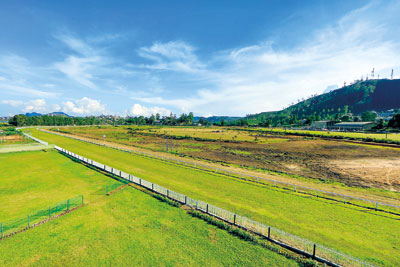Huge stakes at the proposed Nuwara Eliya Training centre

A view of the land where the multibillion project will come to live
The Government is to sign a financial contract with a French company to construct a multibillion rupee high altitude training center at the Nuwara Eliya Racecourse. But the project still awaits clearance from environmental authorities after concerns in the past over possible impacts on one of the country’s prime tourist destinations.
The project includes indoor and outdoor training facilities at an altitude of 1868m (5708 feet). It will cost a staggering 75.5 million or approximately Rs 12.9 billion, expected to be sourced by the contractor. So large is the sum to be expended that the views of Sri Lanka Central Bank’s Monetary Board have been sought regarding its financial implications to the country.
Rejected by the Treasury’s Cabinet Review Committee (CRSC) on two previous instances–in 2009 and 2013–the project was pursued under the Sirisena-Wickremesinghe administration for a third time, notwithstanding a policy decision to suspend all of the previous regime’s unsolicited proposals.
Cabinet first sanctioned the project in December. Ministers subsequently (two weeks ago) approved a request to enter into the financial agreement with the French contractor, Ellipse Projects SAS. The company advertises itself online as an engineering and contracting firm that specialises in promotion, development and execution of turnkey infrastructure projects.
According to Cabinet Memorandum MNPEA/2017/068 submitted by Minister of National Policies and Economic Affairs, Elipse Projects SAS was selected by the Ministry of Sports to implement the project under financial assistance from UKEF’s (United Kingdom Export Finance) and Hatton National Bank of Sri Lanka. The Cabinet paper also says UKEF is to finance up to 70 per cent of the project price while the balance 30 per cent is to be source through a local bank.
“Negotiations have been concluded to with the UKEF to obtain a buyer’s credit facility of up to Euro 51,576,006.15 to cover approximately 70 per cent of the contract price of the project and with Hatton National Bank of Sri Lanka (HNB) to obtain a credit facility of up to Sri Lankan rupees equivalent of Euro 23,952,694.76 to cover the remaining balance of the contract value,” the Memo says. The funders have offered a 13-year repayment period including a three-year grace period for repayment.
The training facility will have an indoor sports complex, indoor swimming pool, multi-sport ground, cricket ground, 400-metre synthetic running tracks, 400-metre grass track, two indoor tennis courts, administration block and medical centre, apartment block and a hotel with 75 room facility.
The Memo justifies the cost saying the project is expected to generate considerable amount of foreign currency earnings due to its location which is one of the most favourable locations in the Asia region”. Cabinet consent is subject to the Sports Ministry obtaining approvals from all relevant authorities.
The project will start after all clearances are obtained, said Kamani Suriarachchi, Director (Planning) at the Sports Ministry. When the proposal was floated by Navin Dissanayake during his brief tenure as Sports Minister, there were concerns over its environmental impact. Consequently, the Ministry has asked the Central Environmental Authority (CEA) to carry out an environmental impact assessment (EIA) to ascertain whether the propose development will pose any serious threat to the environment, Mrs Suriarachchi confirmed.
While high-altitude training is definitely be of benefit to athletes, critics question the need for spending such an exorbitant sum for a “fancy” training centre in Sri Lanka when the Government struggles to maintain existing sporting facilities. How will the administration generate returns on the heavy investment?
Sri Lanka has already spent over Rs 3 billion in renovating and building three cricket venues at Kettarama, Pallekele and Sooriyawewa to co-host the 2011 World Cup. The Government has since struggled to settle the bills; millions are still owed to State-owned institutions. The country’s only multi-sport venue, Sugathadasa Stadium, is in a dilapidated state–so much so that the Athletics Association of Sri Lanka is compelled to send its Asian Championship-bound athletes for a month-long training in India.
“This is no doubt a very good thing but do we need such a high profile one?” asked Attorney-at-Law Panduka Keerthinanda, a former Chairman of the Sugathadasa National Sports Complex Authority. “Look at the state of Sugathadasa Stadium. For years, we have struggled to maintain that and today it’s in a complete dilapidated state. In such scenario do you think it’s financially viable to invest on another multimillion dollar project?”
Earlier, in 2009 when Gamini Lokuge was at the helm of the Ministry of Sports, Rs 200 million was spent to develop the infrastructure in the 34-hectare land. It was abandoned due to environmental concerns.


